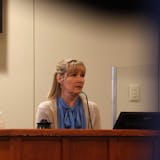WASHINGTON – The U.S. Environmental Protection Agency validated new testing methods Thursday to measure the presence of widespread contaminates called PFAS in the nation's drinking water.
PFAS, an acronym for per- and polyfluoroalkyl substances, have been linked to liver, reproductive, cholesterol and immune issues in humans, as well as cancer in lab animals. The EPA has issued a lifetime health advisory on the amounts of two specific kinds of PFAS in drinking water. But it has not set mandatory limits for any of thousands of different variations of the chemicals.
The new testing protocol will expand the number of PFAS measured in drinking water to 29, up from 18.
In a news release, EPA Administrator Andrew Wheeler called the expansion an "important scientific advancement."
PFAS are known as "forever chemicals" because they don't break down in nature and build up in humans exposed to them.
Maplewood-based 3M and other major PFAS producers and users, including DuPont and Chemours, face a slew of public lawsuits stemming from PFAS fouling drinking water, surface water and soil. Private personal-injury actions are being considered, as well as shareholder lawsuits brought by stock owners who say companies ignored their own research that showed PFAS were potentially dangerous.
Though it discontinued production and use of two types of PFAS in 2002, 3M has testified under oath that the "majority of evidence does not indicate" that PFAS have not hurt anyone at the level at which they exist in the environment.
PFAS are used to make products resistant to heat, stains and water. Teflon and 3M's Scotchgard product contain PFAS.



